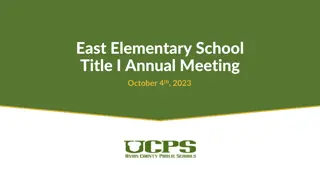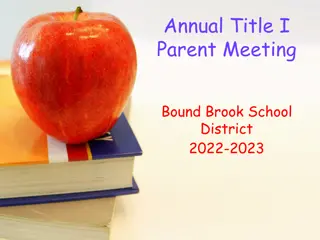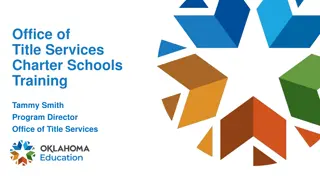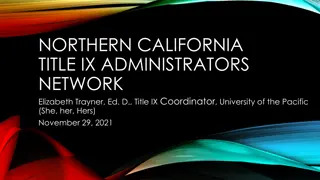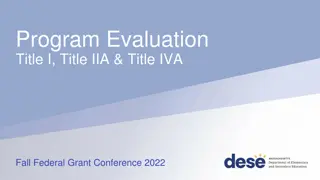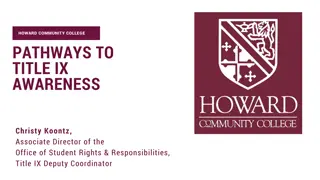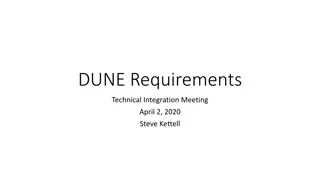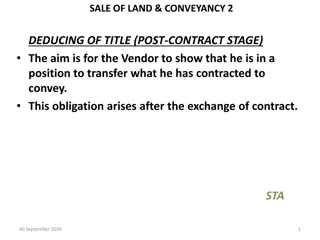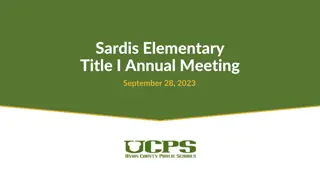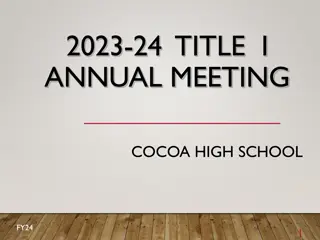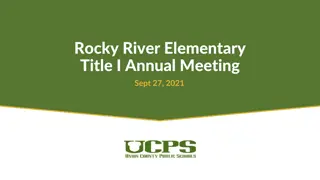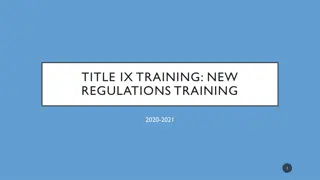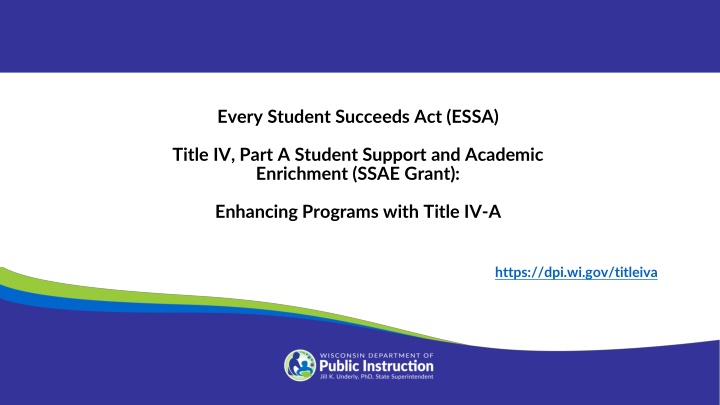
Enhancing Programs with Title IV-A: Key Takeaways and Objectives
Explore key takeaways from a presentation on enhancing programs with Title IV-A grants, emphasizing the importance of data-driven decisions, stakeholder feedback, equity, evidence-informed strategies, and documenting impact. Understand how funds are allocated to LEAs and the objectives of Title IV, Part A in providing a well-rounded education and improving learning conditions.
Download Presentation

Please find below an Image/Link to download the presentation.
The content on the website is provided AS IS for your information and personal use only. It may not be sold, licensed, or shared on other websites without obtaining consent from the author. If you encounter any issues during the download, it is possible that the publisher has removed the file from their server.
You are allowed to download the files provided on this website for personal or commercial use, subject to the condition that they are used lawfully. All files are the property of their respective owners.
The content on the website is provided AS IS for your information and personal use only. It may not be sold, licensed, or shared on other websites without obtaining consent from the author.
E N D
Presentation Transcript
Every Student Succeeds Act (ESSA) Title IV, Part A Student Support and Academic Enrichment (SSAE Grant): Enhancing Programs with Title IV-A https://dpi.wi.gov/titleiva
Enhancing Programs with Title IV Enhancing Programs with Title IV- -A A In the Chat: What were your key takeaways from the presentation?
Key Takeaways Key Takeaways Allocate and claim carryover amounts by June 30th Build a team Use data to driven decisions Ensure stakeholder feedback is collected and used Direct funds toward students of greatest need (Equity) Align Title IV-A plan with District initiatives Use evidence-informed strategies Document the impact of funded activities
Enhancing Programs with Title IV Enhancing Programs with Title IV- -A A Question & Answer
Objectives for Today Objectives for Today Understand how funds are allocated to LEAs Understand the intent and expectations of Title IV, Part-A Explore how LEAs can use funds Explore new resources and guidance Understand which Title IV-A funds will lapse
How Funds Are Allocated to LEAs How Funds Are Allocated to LEAs Initially awarded late in the 17-18 school year LEAs with previous year Title I allocation receive a minimum of $10,000 each fiscal year. 1. 2. State allocation has generally increased each year Plan for continued funding/strategic use of funding enhancement of current services or new strategies aligned with student need evidence-based or promising practice data-driven decisions 3. 4.
Objectives of Title IV, Part A Objectives of Title IV, Part A Provide access to, and opportunities for, a well- rounded education for all students (section 4107) Improve conditions for learning in order to create a healthy and safe school environment (section 4108) Provide access to personalized learning experiences and effective use of data/technology supported with high quality professional learning opportunities(section 4109 1. 2. 3.
Educational Equity Educational Equity Educational equity means that every student has access to the educational resources and rigor they need at the right moment in their education across race, gender, ethnicity, language, disability, sexual orientation, family background and/or family income. https://dpi.wi.gov/statesupt/every-child- graduate
Assurances for Title IV, Part A Assurances for Title IV, Part A Prioritize the distribution of funds based on one or more of the following criteria: Are among the schools with the greatest needs Have the highest percentages or numbers of children counted under section 1124(c) Are identified for comprehensive support and improvement Are implementing targeted support and improvement plans Are identified as a persistently dangerous
Title IV Title IV A Monitoring A Monitoring Evidence of data-driven decisions Evidence that funds are targeted to schools/groups of highest need Evidence that activities align with program outcomes Evidence of how activities are being evaluated Evidence of ongoing stakeholder feedback
Stakeholder Feedback Stakeholder Feedback Diverse stakeholder feedback is required by statute o Stakeholders include teachers, principals, other school leaders, specialized instructional support personnel, charter school leaders, parents, community partners, and local government representatives o Determine best avenues to educate and collect feedback on district plan for funds o Documentation required during monitoring
Designate a Collaborative Title IVA Team Designate a Collaborative Title IVA Team Who are your cross-district financial and program decision -making teams to connect IVA funding to your strategic goals: Superintendent, Teaching and Learning, Business Office and Financial, Instructional Technology, Student Services, Building Principals Other Key Stakeholders
Ideation Process for Innovative Programming Ideation Process for Innovative Programming Empathize Generate an idea aligned and gather inspiration to data or evidence-based needs for all students Define Ideate Align your plan with WISEGrants WUFAR codes, goals and evaluation of IVA to submit final proposal Prototype Create implementation plan with your instructional team to support innovative and equitable programming opportunities Test Evaluate effectiveness of program related to evidence or data to continue funding and /or expansion of programming Assemble your district team to review all funding sources and use of IVA to support supplemental programs for all students
DPI Website DPI Website https://dpi.wi.gov/titleiva https://dpi.wi.gov/titleiva
Allowable Costs: Five Essential Questions Allowable Costs: Five Essential Questions Questions for Consideration Does the activity align with identified need? Does the activity meet basic requirements under Title IV-A? Is it a reasonable use of federal funds? Does it align with district policy and procedure? Is it supplanting?
Examples of Allowable Activities Examples of Allowable Activities - - 4108 4108 Student Physical/Mental Health Drug and violence prevention Health/safety practices in schools and athletics School-based health and mental health services Healthy, active lifestyle, nutritional education Physical activities Trauma informed classroom management Preventing use of alcohol, tobacco, marijuana Chronic disease management Safe and Supportive Schools Preventing bullying/harassment Relationship-building skills Dropout prevention Re-entry programs for justice involved youth Child sexual abuse awareness Reducing use of exclusionary discipline Suicide prevention Violence prevention Crisis management/conflict resolution Preventing human trafficking Culturally responsive teaching
Examples of Allowable Activities Examples of Allowable Activities - - 4107 4107 Improving access to foreign language, arts, music Supporting college/career counseling Programming to improve instruction and engagement in STEM Promoting access to accelerated learning opportunities Strengthening instruction in American history, civics, economics, geography, government education, environmental education Supporting activities in social emotional learning (SEL)
Examples of Allowable Activities Examples of Allowable Activities - - 4109 4109 Supporting high quality PD to educators to personalize learning and improve academic achievement Building technological capacity Carrying out innovative blended learning projects Providing students in rural/underserved areas with resources to benefit from high-quality digital learning opportunities Delivering specialized or rigorous academic courses using digital learning technologies and assistive technology
Promising Practice Promising Practice Evidence-based program selection -Tier 1- Strong Evidence -Tier 2-Moderate Evidence -Tier 3- Promising Evidence -Tier 4- Demonstrates a Rationale Evidence-Based Improvement Strategies presentation Online Databases for Investigating Evidence-Based Improvement Strategies
Tydings Tydings Amendment and ESEA Waiver Amendment and ESEA Waiver Due to previous waivers, both 2019-20 and 2020-21 funds will lapse. Carryover funds should be allocated by June 30, 2022. There are no waivers in place for the 2021-22 Title IV-A funds 2021-22 funds can carryover at 100%
Budget Sidebar Summary Budget Sidebar Summary
Title IV, Part A Resources Title IV, Part A Resources DPI Title IV-A Resource Website https://dpi.wi.gov/titleiva Title IV-A District Allocations https://dpi.wi.gov/titleiva/district-funding-allocations DPI WISEGrants Web Portal https://dpi.wi.gov/wisegrants/web-portal Title IV-A Needs Assessment Tool https://safesupportivelearning.ed.gov/title-iv-part-lea-needs-assessment-tool US Department of Education - Non-Regulatory Guidance https://www2.ed.gov/policy/elsec/leg/essa/essassaegrantguid10212016.pdf
Title IV, Part A Contacts Title IV, Part A Contacts Safe and Healthy Students (4108) and Allowable Costs Emily Holder, Title IV-A Program Coordinator emily.holder@dpi.wi.gov Well Rounded Educational Opportunities (4107) Janice Mertes, Assistant Director Teaching and Learning -Digital Learning janice.mertes@dpi.wi.gov Effective Use of Technology - Digital Learning (4109) Janice Mertes, Assistant Director Teaching and Learning -Digital Learning janice.mertes@dpi.wi.gov

